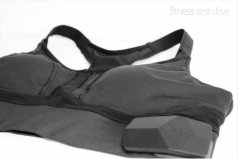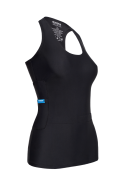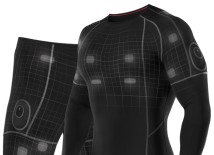What is a Smart sports garment?
Smart sports garments or smart performance garments is a relatively new product segment in the consumer sports tech market. There are probably different views of what the definition should be, but for the purpose of this post, it is a sports garment with embedded sensors/electronics. The main functions of sports garments include providing covering, protection, comfort, ease of movement and some might say making the athlete more aesthetically pleasing. Then with the added sensors and electronics, there generally are two different types of secondary functions.
The more common one is the passive function where sensors monitor stuff on an athlete, either physiological measurements or physical movements. It can make smart evaluations based on the data and give real-time feedback suggesting to the athlete that they should push harder or rest or correct their technique etc. But the decision to act on that suggestion still lies with the athlete or coach. There is also the not-so-common active function where the garment does something to the user. For example giving electrical muscle stimulations (EMS) or possibly electric shocks. But so far the “electric shock” feature is only found on a wristband and hasn’t extended to any other wearables yet. I am not sure why that is the case. For EMS, it has been said that it helps with muscle strengthening which is good for rehab or as a complementary training tool. But I will not go into it since it’s beyond my area of expertise.
R&D in Melbourne
A while ago, I had the opportunity to be a lab rat for a mate’s PhD thesis. He has developed a patented novel technology to measure muscle activity and hopefully able to predict the risk of muscle and knee injuries in elite athletes. The experiment I took part in was basically collecting a bunch of data from this novel sensing technology, wireless electromyography (EMG) sensors, a motion capture system, and a bike trainer. Unfortunately, it also involved me pedalling for my life.
How is this relevant to smart garments? Well, the novel sensors and EMG sensors were all hidden under a compression garment with motion capture markers secured on the outside. The compression tights ensure that the sensors remain where they are (and reliably capture data) and they also (coincidentally) facilitate motion capture. Albeit it was a very crude way of combining the sensors and the 2XU tights, it was a functional prototype (of sorts), and the ultimate goal would be to have those novel sensors built into compression tights.

Lab rat in action
As we discussed further on commercialising this novel sensing technology for smart sports garments or developing smart compression garments with any wireless sensors, it became apparent that there are a number of challenges. Here’s just a few:
Washing and durability :: A sports garment is going to get sweaty and smelly a lot more than everyday garments. So it definitely needs to get washed. Most smart garments in the market have an electronics module (IMU, BLE module, battery etc) that is removable because they will not survive a tumble in the washing machine. However, there are still conductive pads or conductive yarns (for electrical connections). Would long term washing affect their conductivity and so usefulness? (A research has shown that most conductive threads will be affected although some hold up better.)
Sensor data accuracy :: In order to capture accurate & robust data, the sensors have to be positioned in the correct location each and every time the smart garment is put on. For measuring stuff like heart rate or EMG, it needs to maintain skin contact for proper measurements. If sensor positions are off (by a bit too much) or skin contact is not maintained, the data collected becomes meaningless and cannot be compared with previous data sets. Not to mention the effect of sweat on EMG electrodes.
Custom fitting :: This relates closely to the above point. Most sports compression wear are made in standard sizes. Sometimes one might find their compression garment being a bit too long at the legs or too short for the arms or too tight around a joint and too loose at a certain spot. It’s fine on a regular compression garment. But when sensors come into play, especially when there is fabric type of sensors (that measures compression or stretch), perhaps a custom-fit garment could be a more optimal solution.
Application :: This is possibly the most important challenge – designing a smart sports garment that solves a real need. It could be a very niche area or a wide-spread problem. But the starting point would be talking to athletes, coaches and sports scientists, to identify where the need is or what needs to be tracked. Then the smart garment that is developed would be a solution and not just a cool piece of technology.
What’s in the marketplace
Having said that, over the last 4-5 years, more than a handful of companies have taken up these challenges and developed their own smart sports garments. A quick search on google shows that there are at least 5-6 smart sports garments in the market.
|
Brands / Companies
|
Measured parameters | ||||
| Heart rate | Breathing frequency | EMG | Motion | 3D motion (joints) | |
| OmSignal | ✔ | ✔ | ✔ | ||
| Hexoskin | ✔ | ✔ | ✔ | ||
| Athos | ✔ | ✔ | ✔ | ✔ | |
| Myontec | ✔ | ✔ | |||
| Heddoko | ✔ | ✔ | |||


OmSignal and Hexoskin have smart garments that are an extension of heart rate monitors with an added IMU (Inertia measurement unit) which provides parameters such as breathing rhythm, running cadence, step count and more. While they both seem to be generic fitness trackers when they first came out, it looks like Omsignal has now dropped their original Omshirt and focused on a women-specific product (the Ombra) for running. This might have to do with a review like this: link.


Myontec and Athos are smart compression garments with surface EMG sensors. The point of putting on these garments is for the user to know what’s going on with specific muscle groups during their run, cycle or gym workout. Myontec is focused on the lower body (quadriceps and hamstring) with an emphasis on running and biking, while Athos covers the whole body looking at general strength training. It is cool that their accompanying software/app provides feedback of which muscles should be activated more during a squat (or other exercises) but I think it might be better if they could correct a user’s posture/technique that is causing the wrong muscles to be activated.

Heddoko is a full body compression suit that measures a user’s 3D motion much like the Xsens suit. The difference is that the Heddoko suit uses less number of IMU and has embedded stretch sensors, which makes it unique. Assuming the measurements are accurate and repeatable, it has lots of potential applications in sports biomechanics and injury prevention. But based on this video, they are still validating their sensors and trying to work out specific applications.
Some additional thoughts
On one hand, it is cool that there is all these performance tracking technology available to the average athlete – such as wireless EMG and 3D motion analysis (again, assuming the measurements are robust). On the other hand, I wonder if the benefits would outweigh the costs because they are mostly quite expensive and I am not sure if the average gym goer would need that much information about their workout. Perhaps they would be more useful to elite or professional athletes, especially where professional teams have coaches and sports scientists to analyse the data, and give custom feedback. They could also couple it with video playback and analysis so that there is more context to the data.
I think for the average athlete, a smart garment might be useful if they are going through physical rehab and need to monitor certain movements or muscle groups while under the guidance of a physical therapist. Or if they are trying to pick up a specific skill like throwing a football or baseball (In fact, there are sensor embedded sleeves that do just that, which I might discuss another time). Basically, there should really be a specific ‘pain’ to solve. A smart garment with a generic health and fitness application is probably not going to be of much use. Wristbands and smart watches already try to do that.
Do you already own a smart sports garment or are thinking of getting one? If yes, do leave a comment. I would love to hear your thoughts and what you would use it for. Thanks for reading!
